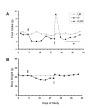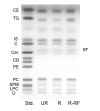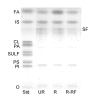Caloric restriction in C57BL/6J mice mimics therapeutic fasting in humans
- PMID: 16709251
- PMCID: PMC1513228
- DOI: 10.1186/1476-511X-5-13
Caloric restriction in C57BL/6J mice mimics therapeutic fasting in humans
Abstract
Background: Caloric restriction (CR) has long been recognized as a dietary therapy that improves health and increases longevity. Little is known about the persistent effects of CR on plasma biomarkers (glucose, ketone bodies, and lipids) following re-feeding in mice. It is also unclear how these biomarker changes in calorically restricted mice relate to those observed previously in calorically restricted humans.
Results: Three groups of individually housed adult female C57BL/6J (B6) mice (n = 4/group) were fed a standard rodent chow diet either: (1) unrestricted (UR); (2) restricted for three weeks to reduce body weight by approximately 15-20% (R); or (3) restricted for three weeks and then re-fed unrestricted (ad libitum) for an additional three weeks (R-RF). Body weight and food intake were measured throughout the study, while plasma lipids and levels of glucose and ketone bodies (beta-hydroxybutyrate) were measured at the termination of the study. Plasma glucose, phosphatidylcholine, cholesterol, and triglycerides were significantly lower in the R mice than in the UR mice. In contrast, plasma fatty acids and beta-hydroxybutyrate were significantly higher in the R mice than in the UR mice. CR had no effect on plasma phosphatidylinositol levels. While body weight and plasma lipids of the R-RF mice returned to unrestricted levels upon re-feeding, food intake and glucose levels remained significantly lower than those prior to the initiation of CR.
Conclusion: CR establishes a new homeostatic state in B6 mice that persists for at least three weeks following ad libitum re-feeding. Moreover, the plasma biomarker changes observed in B6 mice during CR mimic those reported in humans on very low calorie diets or during therapeutic fasting.
Figures




Similar articles
-
Glucose reduces the anticonvulsant effects of the ketogenic diet in EL mice.Epilepsy Res. 2014 Sep;108(7):1137-44. doi: 10.1016/j.eplepsyres.2014.05.010. Epub 2014 Jun 2. Epilepsy Res. 2014. PMID: 24938543
-
Caloric restriction inhibits seizure susceptibility in epileptic EL mice by reducing blood glucose.Epilepsia. 2001 Nov;42(11):1371-8. doi: 10.1046/j.1528-1157.2001.17601.x. Epilepsia. 2001. PMID: 11879337
-
Effects of phentermine and phenformin on biomarkers of aging in rats.Gerontology. 2005 Jan-Feb;51(1):19-28. doi: 10.1159/000081430. Gerontology. 2005. PMID: 15591752
-
The influence of feeding and fasting on plasma metabolites in the dogfish shark (Squalus acanthias).Comp Biochem Physiol A Mol Integr Physiol. 2010 Apr;155(4):435-44. doi: 10.1016/j.cbpa.2009.09.006. Epub 2009 Sep 24. Comp Biochem Physiol A Mol Integr Physiol. 2010. PMID: 19782147 Review.
-
Impact of caloric and dietary restriction regimens on markers of health and longevity in humans and animals: a summary of available findings.Nutr J. 2011 Oct 7;10:107. doi: 10.1186/1475-2891-10-107. Nutr J. 2011. PMID: 21981968 Free PMC article. Review.
Cited by
-
Serum from calorie-restricted rats activates vascular cell eNOS through enhanced insulin signaling mediated by adiponectin.PLoS One. 2012;7(2):e31155. doi: 10.1371/journal.pone.0031155. Epub 2012 Feb 2. PLoS One. 2012. PMID: 22319612 Free PMC article.
-
Effects of cigarette smoke exposure on a mouse model of multiple sclerosis.Toxicol Rep. 2022 Mar 29;9:597-610. doi: 10.1016/j.toxrep.2022.03.032. eCollection 2022. Toxicol Rep. 2022. PMID: 35392156 Free PMC article.
-
Dietary restriction promotes vessel maturation in a mouse astrocytoma.J Oncol. 2012;2012:264039. doi: 10.1155/2012/264039. Epub 2011 Dec 27. J Oncol. 2012. PMID: 22253625 Free PMC article.
-
Role of the hypothalamus in mediating protective effects of dietary restriction during aging.Front Neuroendocrinol. 2013 Apr;34(2):95-106. doi: 10.1016/j.yfrne.2012.12.001. Epub 2012 Dec 20. Front Neuroendocrinol. 2013. PMID: 23262258 Free PMC article. Review.
-
Preconditioning with partial caloric restriction confers long-term protection against grey and white matter injury after transient focal ischemia.J Cereb Blood Flow Metab. 2019 Jul;39(7):1394-1409. doi: 10.1177/0271678X18785480. Epub 2018 Jul 4. J Cereb Blood Flow Metab. 2019. PMID: 29972653 Free PMC article.
References
-
- McCay CM, Crowell MF, Maynard LA. The effect of retarded growth upon the length of life span and upon the ultimate body size. 1935. Nutrition. 1989;5:155–71; discussion 172. - PubMed
-
- Weindruch R, Naylor PH, Goldstein AL, Walford RL. Influences of aging and dietary restriction on serum thymosin alpha 1 levels in mice. J Gerontol. 1988;43:B40–2. - PubMed
Publication types
MeSH terms
Substances
Grants and funding
LinkOut - more resources
Full Text Sources

